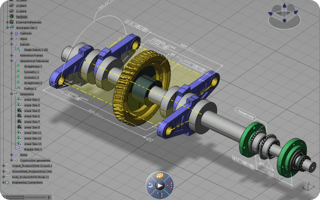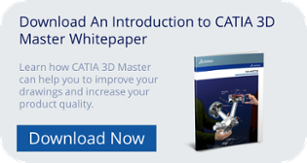 Getting the design of a product right is paramount in the product development process, but it’s not always so easy to do, especially with 2D drawings.
Getting the design of a product right is paramount in the product development process, but it’s not always so easy to do, especially with 2D drawings.
2D drawings have historically been used as the reference point (or rather points) for product definitions. Yet, the confusion of ensuring consistency in tolerances, dimensions and annotations between the sheer volume of 2D drawings can become very frustrating.
Eventually, individuals responsible for downstream activities struggle to understand what’s going on.
But you no longer have to suffer the pain of error-laden drawings with a 3D Design Approach. Using a 3D Design Approach, you can create a single geometrical file that contains all of the dimensions, tolerances and annotations of a part, giving you a single and easily understandable reference point to build your product.
So let’s take a closer look at 3 ways you can benefit from a 3D Design Approach and how these benefits have been enjoyed by real life companies.
1) Reduce Complexity
The problem with 2D drawings is that you need quite a few of them when describing a single, yet highly complex 3D part. And when you make changes to one drawing, you may also need to make changes to a series of other drawings, increasing the chances of errors and costly delays in product development.
But the 3D Design Approach comes to the rescue. Using a single geometric file, tolerances, dimensions and annotations can all be adjusted in a single location, without the need to amend several drawings.
Here’s an example of how one company’s product design process benefitted from the 3D Design Approach:
A company producing helicopters for commercial and military applications were suffering from shop floor errors, poor data quality and really needed to improve their time to market.
Following 6 months of implementing the 3D Design Approach involving 100 designers, a 100% accurate and reliable 3D definition was produced for manufacturing, significantly reducing errors.
The single reference point also eliminated the need for multiple drawings, making the designers’ jobs much easier.
2) Increase Productivity and Efficiency
Given the competitive nature of today’s business environment, organizations need to be quick when it comes to bringing new products to market. So wherever you can shave time off product design, it’s never a bad thing.
One way the 3D Design Approach helps you to do this is by allowing you to re-use product definition information in product families or future versions of the product. By re-using geometric information, you can save time in the development of future products and get your products to market even faster.
It’s even easier when you make use of the templates feature. The 3D Design Approach allows you to create templates with annotations and tolerances that essentially allow you to automate elements of the product design process.
Ultimately, re-using product definitions and utilising templates can help to speed up the product development process and evaluate more designs in less time.
See how one automobile manufacturer was able to significantly increase their productivity by re-using geometric information:
One of the world’s leading automobile manufacturers employed the 3D Design Approach for their body-in-white production. Parts they were working on included a cylinder head that required about 800 tolerances and annotations – now that’s quite a lot.
But using the 3D Design Approach, the company was able to develop parts efficiently by copying functional tolerancing and annotations from existing parts to a new variant.
This meant that 70% of the production definition was ready-made, saving a huge amount of time in product design.
So you can see from the case study how effective the 3D Design Approach can be in increasing productivity though fully utilising original designs to inform the development of new products.
3) Lower Costs
And last but certainly not least, the 3D Design Approach helps to ensure that nobody else’s hands are in your wallet other than your own.
The 3D Design Approach does this by allowing you to Simulate your build variations, which can be done to make sure that the product meets dimensional requirements. By doing this, you open up the possibility to loosen tolerances, which ultimately can lead to huge cost savings of up to 90%.
See how an aerospace company was able to cut their manufacturing costs by utilising a 3D Design Approach:
A major aerospace and defence supplier employed the 3D Design Approach for its aerostructures department, specifically for the tooling design process.
By using the 3D Design Approach, the company was able to reduce their tooling costs by up to 30% through a reduction in errors from inconsistent product definitions.
Overall, you can benefit from the 3D Design Approach in 3 simple ways;
- Reduce Complexity – condense numerous 2D drawings into one 3D geometrical file.
- Increase Productivity and Efficiency – re-use product definitions for future products and create templates of annotations and tolerances to automate parts of the product development process.
- Lower Costs – Simulate builds and save up to 90% on manufacturing costs.
If you want to learn more about how you can benefit from the 3D Design Approach, check out the whitepaper ‘CATIA 3D Master – Drive Accuracy into Your Business’.
.png?width=139&height=70&name=DTE-Logo%20(4).png)

